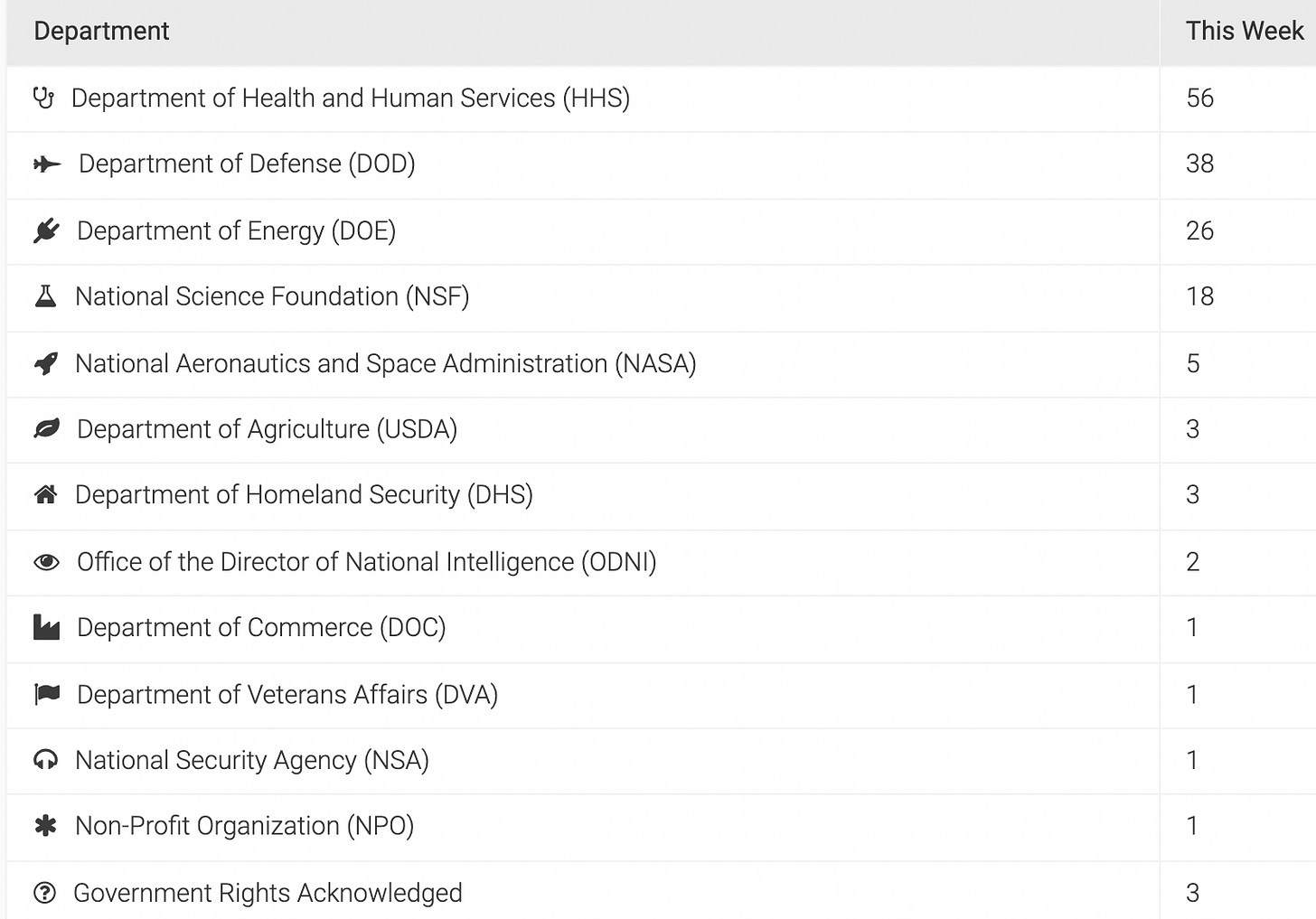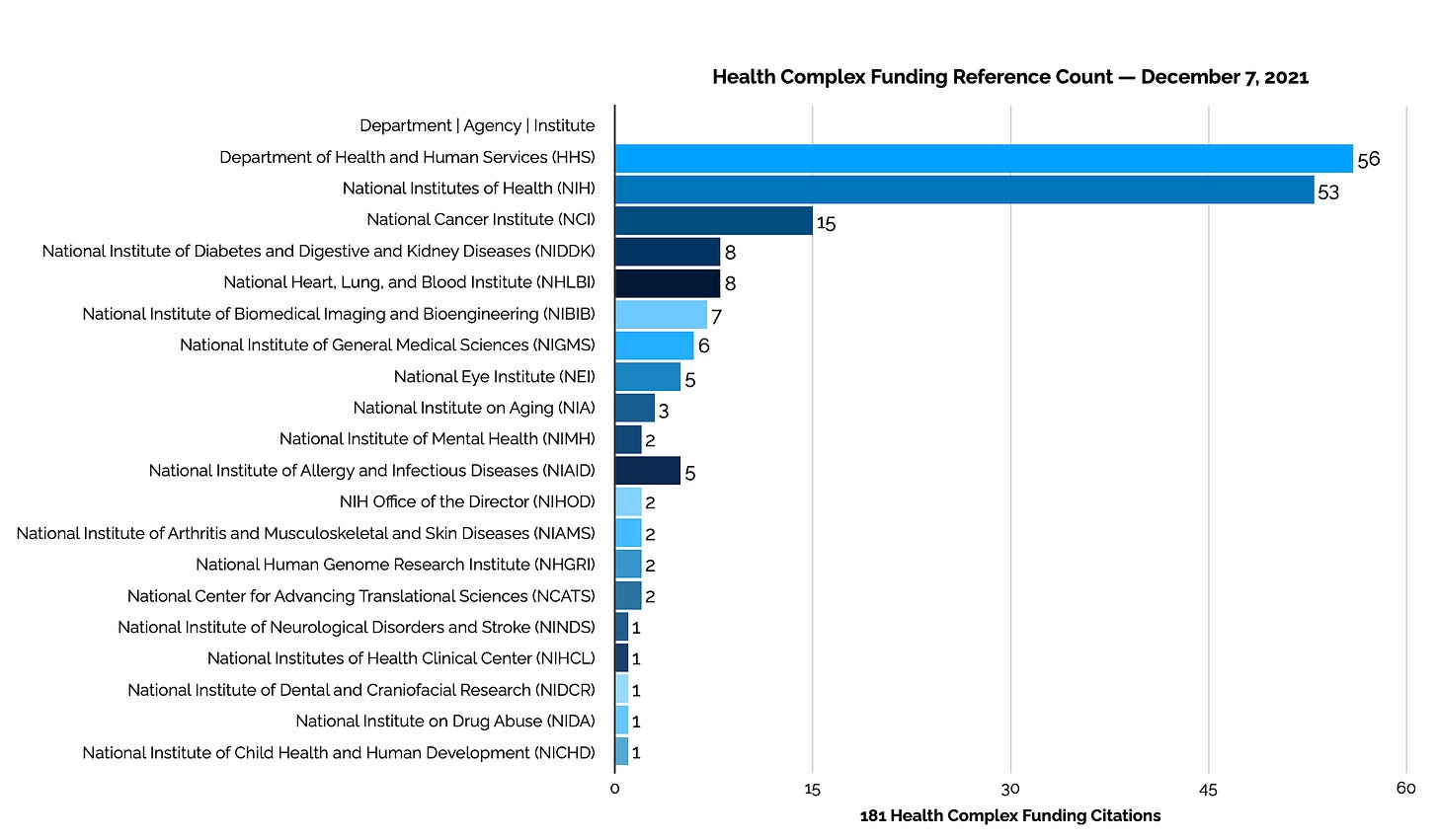Hello from FedInvent,
A Dark Cloud
It's Tuesday, December 7, 2021. Today, the Patent Office granted 6,787 new patents. We found 143 federally-funded patents in the mix. The data was ready by 1:56 AM EST, 12:56 AM CST in Nebraska, where the data magic happens. The FedInvent cross-country half-on-prem and half multi-cloud collaboration infrastructure was percolating. Then, at around 10:30 AM EST, AWS went down. US-EAST-1 AWS region in Virginia went dark and stayed dark until about 6 PM ET. The data-driven federal innovation journalism we were working on came to a screeching halt. FedInvent's information supply chain was disrupted.
(Suddenly, being in the same boat as Netflix, Ring, Venmo, and Amazon wasn't very fun.)
Now we know that the tools we use to analyze the patents running on the AWS-East. While we were waiting for the return of AWS, we put together some thoughts on the current state of affairs of federally funded patents. Fair warning. We are a little grumpy over the dark cloud.
Each Taxpayer-Funded Patents Has A Roadmap
FedInvent focuses on taxpayer-funded inventions and innovation. Unlike the patents from the world's intellectual property-rich market sectors, the inventions in the federal innovation ecosphere map back to the federal objective, a law, and the science and technology policy that goes along with it. Departments and subagencies spell out these goals in requests for proposals, grant funding opportunity announcements, and broad agency announcements. We map the government's R&D spending to the inventions it funded.
The map from a patent, or application, to the federal science policy and innovation map is a rough outline of the landscape. The federal innovation map is more a Lewis and Clark class-map than a National Geospatial Agency class map. Patents are essential milestones in understanding the trajectory of innovation, tangible evidence on where things came from, and where they are going.
FedInvent's goal is to report on this largely undocumented innovation terrain to move from the Lewis and Clark map toward the NGA map. We are working on creating better and better roadmaps on federal science and technology and R&D funding and what we get for our money.
That's Not How It Works
Part of FedInvent's mission is to eschew patent obfuscation — to make information about patents more knowable and easier to digest. The patent world is a bastion of asymmetric information. Big companies understand IP and get patents. Start-ups don't understand IP and are easily duped. They tend to wise up when the first patent troll sends them a demand letter. There's asymmetric information on how the patent IP system works as well. The general public doesn't get the basics no matter how many times USPTO has Intro to Patent webinars. Patent practitioners view knowledge as power and don't like to share.
This asymmetric information conundrum also impacts the journalists who write about federally funded patents. Journalists from publications large and small write articles issues involving federal patents. Two obvious examples are articles NIH and Moderna are in a dispute over SARS-CoV2 vaccination patents. Drug prices are skyrocketing because of patents.
The articles usually get the policy issues right. The patent details, not so much. A patent number is nowhere to be found. Forget a link to the patent. There's also reporting about a company that "got a patent." Is it an actual patent? Not always. Plenty of times, the "patent" in question is actually a published patent application.
Then there's the reporting on politicians demanding that the federal government march in and take patent rights from big pharma entities that got federal funding. Marching in will lower drug prices. First, the government has never exercised its march-in rights on a patent holder. Second, the government doesn't make drugs. The government makes discoveries, makes policy, grants patents, makes decisions on which drugs are safe, and buys a lot of drugs, some of them probably from the very company they want to march in on.
If the government were to march in, they would need to find a contractor to make the drug. That drug would need to go through the FDA approval process. The government and its contractor would need to license a host of other intellectual property that wraps around the process. All of this takes time and lawyers. Add that no pharmaceutical company will give up its patent rights without a fight. A march in by the government would make a lot of patent lawyers and litigators rich. And it wouldn't reduce drug prices anytime soon.
Back to the Moderna v. NIH patent dispute. The federally funded patent at the core of the dispute is getting attention in the press and across the social media/podcast universe. An influential Millennial-focused podcast recently featured a full-on rant by its host on how the Biden Administration should take Moderna's patent and give it to African and South American countries so they can make their own vaccines. The solution? Take the patent, and poof, you have millions of doses of vaccines. There was no discussion about Moderna's trade secrets make making its vaccine possible. How about enabling technology like vials that can handle super low-temperature storage? How about drug quality and control issues and the need to prevent new counterfeit in these developing countries. Nope. Just hand over the patent, and the problem is solved.
Our millennials. who insisted we listen to this podcast, wanted answers on this "vaccine patent thing." After a lot of explanation and a bunch of blank stares, the response we got was, "why do these people make it seem like it's so simple." (Good question.)
The topic then turned to, "the Biden Administration says it's ok with suspending patent rights for COVID-19 (SARS-CoV2) vaccine patents." Here we go again. First, patent owners aren't going to let their patent rights go without a fight. (See march-in discussion above.) Negotiating a new pandemic vaccine policy with the World Health Organization and other global stakeholders will feature lots of meetings, meetings, and more meetings but no immediate solution on how to get the unvaccinated vaccinated. Down the rabbit hole we went again.)
It's The Policy, Not the Patent
This brings us to the ClearView AI face search engine patent. ClearView AI is the company that's been trolling social media sites sucking up pictures of people and their biographic data without their consent or the consent of the platforms on which this data resides. Clearview uses this misappropriated data to create a search tool that lets you throw in an image and find out who is in the picture. According to TechDirt, an outlet that does know how to report about patents, Clearview's facial recognition surveillance database has over 10 billion images it scraped off the internet. More than the FBI and all of the state DMVs combined.
The government is moving to award a lucrative patent for a "search engine for faces," a technology that has members of Congress and privacy advocates up in arms.
The press got wind that Clearview received a Notice of Allowance from the Patent Office that it was about to be granted for what many think is a very dangerous surveillance state tool. Much of the reporting calls on Congress, the President, or the Courts to stop Clearview AI from getting its patent. (How would that work?) One commentator said that the government has a responsibility to look at these patents before they are granted. (Ten thousand Patent Office patent examiners who look at patents all day long aren't enough?)
In the meantime, Clearview is busy getting sued by Facebook, Twitter, Google, and Venmo for scaping copyrighted content from social media sites. State governments are after the company for violating their privacy laws and collecting citizens' pictures without permission. Civil rights and immigration activists have also filed class-action lawsuits against the firm claiming that Clearview's "biometric surveillance" violates its constituent's constitutional rights. Clearview's product has put it in the middle of a pretty messy situation.
While all this hand ringing on about ClearView getting a patent is going on, the National Institute of Standards and Technology (NIST) announced that Clearview placed among the top 10 out of nearly 100 facial recognition vendors in a federal test intended to reveal which tools are best at finding the right face while looking through photos of millions of people. The FBI and other law enforcement agencies use its service to identify people in pictures that are part of its investigations. Most notably, to identify people storming the Capitol on January 6th. Civil society and state governments are going after Clearview while the feds buy its products.
The problem here isn't the patent. It's the policy. The FedInvent take is on the Clearview patent is that this is a very creepy invention. Is it novel? Some parts of it are. Is it useful? Yes, but for whom? Is it obvious? Kind of. Technology policymakers should be reading this patent, really reading it, and using it to write policies to stop Clearview from violating our privacy and taking social media content without consent. The patent is the least of the problems here.
(Clearview's patent application 20210042527 was published on February 11, 2021. The Notice of Allowance was mailed on December 1, 2021.)
And?
Whether you are a patent maximalist or an advocate for making changes in the patent system, the patent ecosphere would benefit from more people understanding how the system works.
We'll put our soapbox away and get back to reporting on this week's taxpayer-funded patents.
Now it's Wednesday. At 4 AM this morning the Wayfinder Digital website went dark. Another dark cloud. It took a long time on hold with the web hosting company to fix it.
Today, we will stick with the numbers to get this newsletter out before some other cloud thing breaks.
The FedInvent Report
The FedInvent Patent Report is available here. If you prefer to explore by the Department that funded the R&D that led to the patents, start here.
Patents By The Numbers
The Patent Office granted 6,760 new patents on Tuesday, December 7, 2021. One hundred forty-three (143) benefitted from taxpayer funding. Here are the numbers.
One hundred thirty-four (134) patents have Government Interest Statements.
Thirty-three (35) have an applicant or an assignee that is a government agency.
The 143 new patents have 158 department-level funding citations.
These patents are the work of 467 inventors.
The 451 American inventors come from 34 states and the District of Columbia.
The Big Three States:
California has 20 first-named inventors and 73 total inventors.
Massachusetts has 19 first-named inventors and 52 total inventors.
Maryland has 11 first-named inventors and 34 total inventors.
The sixteen (16) foreign inventors come from seven (7) countries.
There are 81 patents (57%) where at least one assignee is a college or university, the HERD.
Federally Funded Research and Development Centers (FFRDCs) received ten (10) patents.
A federal department is an assignee on 23 patents.
There are three Bayh-Dole scofflaws this Tuesday. Raytheon, Honeywell, and HRL Laboratories.
Patent Count By Department
Patents By Technology Center
The charts below show the Technology Center where this week's patents were examined. This week there was one re-examination patent in the FedInvent taxpayer-funded patents mix.
The Health Complex
The table below shows the funding citations for patents where the recipient cites the Department of Health and Human Services (HHS), the institutes at the National Institutes of Health, and other subagencies that are part of HHS, the Health Complex.
Before We Go
Bob Dole, half of the eponymous team responsible for the Bayh-Dole Act has passed away Sunday at the age of 98. His long career of public service to our country was extraordinary.
As usual, there are many more taxpayer-funded patents than we can cover here. Please explore the FedInvent Patent Report. It's an important addition to your newsletter subscription.
If you'd like to catch up on earlier FedInvent Reports, you can access the newsletters here on Substack. In addition, the reports are available on the FedInvent Links page.
If you aren't a paid subscriber yet, please consider subscribing. It will help us keep the lights on.
Thanks for reading FedInvent. We'll see you next later this week with the latest on the federal innovation ecosphere.
The FedInvent Team
FedInvent is the home of data-driven journalism about taxpayer-funded innovation. We tell the stories of inventors, investigators, and innovators. Wayfinder Digital's FedInvent Project follows the federal innovation ecosphere, taxpayer money, and the inventions it pays for.
FedInvent is a work in progress. Please reach out if you have questions or suggestions. You can reach us at info@wayfinder.digital.










